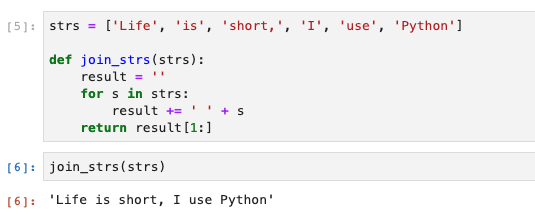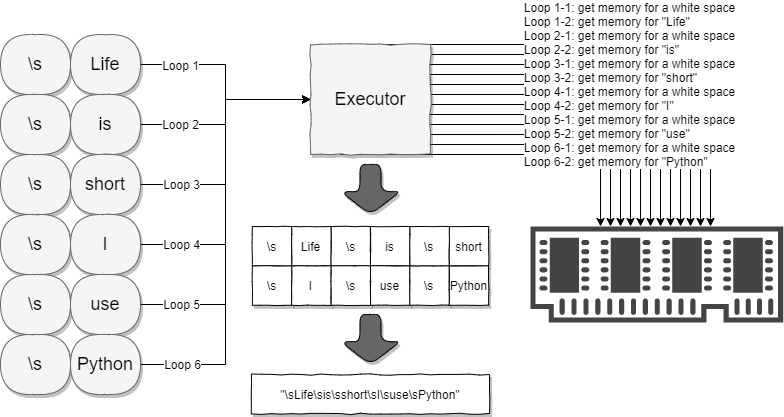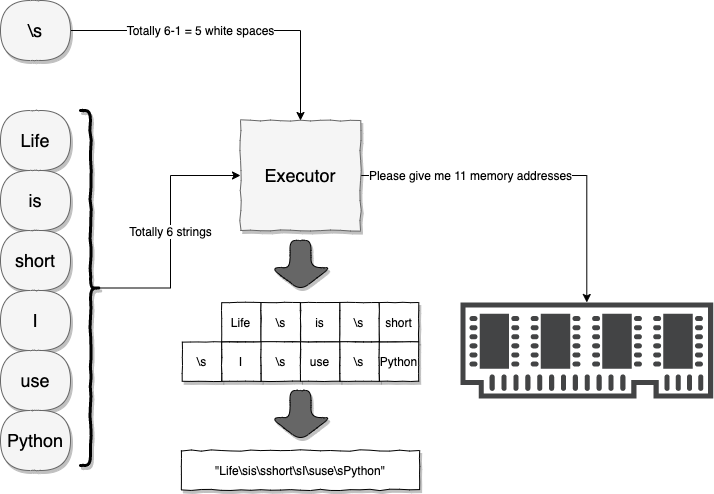How To Use Join In Python

Practise Not Use "+" to Join Strings in Python
A comparison of the approaches for joining strings in Python, using "+" and join() method.
When I start to use Python, information technology is very intuitive and piece of cake to come out to apply the plus operator + to bring together string, as many programming languages practise such as Coffee.
However, shortly I realised that many developers seem to like to apply the .join() method rather than +. In this article, I'll introduce what'southward the differences between these 2 approaches and why you should not utilize +.
Kickoff
As a beginner, or someone has just switched from other languages that use + to bring together strings, it is very easy to write code like this:
str1 = "I love "
str2 = "Python." print(str1 + str2)

Every bit you use Python more than and more, you lot may realise that someone else prefers to use the bring together() method like this:
str1 = "I dear "
str2 = "Python." print(''.bring together([str1, str2]))

Honestly, when I saw the above method beginning time, I was thinking that this is non intuitive and looks kind of ugly.
Bring together Multiple Strings
Nevertheless, one time I need to bring together multiple strings in a listing.
strs = ['Life', 'is', 'curt,', 'I', 'use', 'Python'] Initially, I accept washed it like this:
strs = ['Life', 'is', 'short,', 'I', 'use', 'Python'] def join_strs(strs):
result = ''
for s in strs:
result += ' ' + due south
return effect[1:] join_strs(strs)

In this example, I have to write a for-loop to join the strings one by one. Also, the result string needs to exist trimmed a white space I added at the beginning because all the strings need to exist added a white infinite in the front, but not the first one. You may have other solutions such as calculation an index to the for loop so that the string at the index = 0 should not be added this white space. Anyhow, you will nonetheless demand this for-loop and do something for the white spaces.
After that, I recalled that I've seen the .join() method before, perhaps this is the fourth dimension that I need to use information technology!
def join_strs_better(strs):
return ' '.join(strs) join_strs_better(strs)

How piece of cake it is! One line of code does everything. Since the .join() method is called by a string object, the string object will be utilised to bring together every string in the list, then you don't demand to worry nearly the white spaces at the beginning.
But wait, exercise y'all really recollect this is the only reason why we demand to utilise the join() method rather than +? No, please read the adjacent section.
Logic Backside join() Method
Now, let's compare these two methods in terms of their functioning. We can use the magic method%timeit of Jupyter Notebook to evaluate them.

The operation shown higher up is based on 100k trials so that the results are very confident and obvious. Using thejoin() method can be 4 times faster than using + to bring together the strings in the list.
Why?
Here is a conceptual graph that I drew for demonstrating of the approach using + to join the strings.

This shows what the for-loop and the + operator did:
- For each loop, the string is plant from the listing
- The Python executor interprets the expression
upshot += ' ' + sand apply for memory address for the white space' '. - Then, the executor realise that the white infinite needs to be joined with a cord, and then it will employ for retentivity address for the string
s, which is "Life" for the first loop. - For every loop, the executor volition need to utilize for memory address twice, one for the white spaces and the other one is for the string
- At that place are 12 times retentivity allocations
Withal, what happened for join() method?

- The executor will count how many strings in the list. There are 6.
- It ways that the cord that is used to join the strings in the list will need to be repeated 6–ane=5 times.
- Information technology knows that in that location are totally 11 memory spaces are needed, and so all of these will exist practical at one time and be allocated upfront.
- Put the strings in society, render the outcome.
Therefore, it is obvious that the major difference is that the number of times for retentiveness allotment is the main reason for the operation improvement.
Imagine that it is already 4x faster to use thebring together() method to bring together vi strings together. What if we are joining a very large number of strings? It will brand a much larger difference!
Summary
In this brusk article, I accept compared the differences between the + operator and the join() method when joining strings in Python. Apparently, the join() method is preferred because of its performance.
Learning a programming language is usually a long curve, just Python makes it relatively shorter for beginners, which is absolutely dandy. After we have entered the door, commencement to use Python, we should non finish at that place and satisfy what we can do utilize Python. Usually, the difference betwixt a chief and a regular developer comes from the knowledge in particular.
Permit'south keep finding more tips on Python to make ourselves closer to a Python Master!
If you feel my articles are helpful, please consider joining Medium Membership to support me and thousands of other writers! Click the above link.
How To Use Join In Python,
Source: https://towardsdatascience.com/do-not-use-to-join-strings-in-python-f89908307273
Posted by: cartwrightpospot.blogspot.com


0 Response to "How To Use Join In Python"
Post a Comment